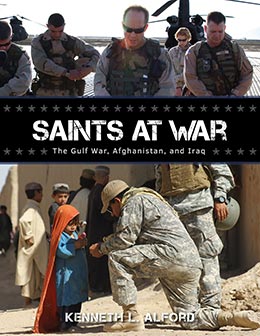Church Organization
Kenneth L. Alford, “The Iraq War: Church Organization,” in Saints at War: The Gulf War, Afghanistan, and Iraq (Provo, UT: Religious Studies Center, Brigham Young University; Salt Lake City: Deseret Book), 196‒97.
Latter-day Saints were involved throughout the Iraq War. For the first six years of the war, 2003–9, while Church members serving in Iraq nominally fell under the direction of the Arabian Peninsula Stake, they generally organized and operated independently. Whenever there were more than a few Church members at the same location, they organized themselves as service member groups of various sizes. Following the successful creation of the Kabul Afghanistan Military District in 2008, Church leaders decided in 2009 to create a similar organization for the approximately 1,300 members of the Church who were serving in Iraq.
On November 9, 2009, Elder Paul B. Pieper of the Seventy and a member of the Middle East/
Commenting on the creation of this wartime military district, Frank Clawson, the Church’s director of military relations and a retired Air Force colonel, stated, “The big difference is without a district we can only have service-member groups. A group leader can hold worship services and provide the sacrament to members, but he does not have priesthood keys. With keys present, it is possible to meet the full range of spiritual needs of our servicemen and women.”[3]
The district presidency soon organized several branches. The first three branches were Taji (thirty-eight miles north of Baghdad), Victory Base Complex (near the Baghdad Airport and Al Faw Palace), and Union Three Base (in Baghdad’s Green Zone). President Hollingsworth remembers there were “upwards of thirty-five different servicemen groups throughout Iraq when the district was formed, varying in size from one person to fifty or more.”[4] Three additional branches were organized later in Balad, Mosul, and Tallil.[5]
The newly created military district operated similarly to the district in Afghanistan. “The single weekly church service was a hybrid of sacrament meeting and Sunday School and was a sight to see. Some soldiers would come in from grueling training of Iraqi soldiers or some would come from a firefight—dirty, grungy, stinky, tired, often after 24-hour operations, but they did not want to miss the chance to take the sacrament. They laid their weapons of war on the floor and humbly renewed their covenants with the Lord. Those meetings were always on Friday.”[6]
Priesthood leaders and members relied heavily on “the use of Internet technologies such as e-mails, Internet telephone and social networking sites” to complete their gospel assignments and care for each other.[7] U.S. Army Colonel Greg Adams, who served as second counselor in the first district presidency, noted that “a district high council was formed as well as a Relief Society presidency. The first Latter-day Saint institute classes in Iraq were also started. In short, we were able to see the Lord bless the members in Iraq and prepare for a greater work in the future.”[8]
Baghdad Iraq Military District | |||
Organized November 9, 2009 | |||
District President | Called | Released | |
1. | Guy M. Hollingsworth | November 2009 | March 2010 |
2. | Jim Phipps | March 2010 | November 2010 |
3. | Gus Arthur Checketts | November 2010 | March 2011 |
4. | Kevan Kay Jacobson | March 2011 | December 2011 |
Deactivated December 31, 2011 | |||
Table 3. Baghdad Iraq Military District.
Notes
[1] Encyclopedia Britannica Online, s.v. “Iraq War,” britannica.com/
[2] You can read more about the creation of the Baghdad Iraq Military District in Guy M. Hollingsworth’s submissions in this section.
[3] Jamshid Askar, “Military District in Iraq Will Be ‘Big Difference,’” Church News, November 21, 2009.
[4] Askar, “Military District in Iraq.”
[5] Guy M. Hollingsworth to author, email, January 26, 2019.
[6] Guy M. Hollingsworth to author, email, January 30, 2019.
[7] Guy M. Hollingsworth to author, email, January 26, 2019.
[8] Askar, “Military District in Iraq.’”
